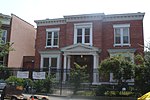Greenpoint station
Brooklyn railway station stubsFormer Long Island Rail Road stations in New York CityGreenpoint, BrooklynRailway stations closed in 1885Railway stations in Brooklyn ... and 1 more
Railway stations in the United States opened in 1878
Greenpoint was the terminal train station for the Evergreen Branch of the Long Island Rail Road. Greenpoint station opened on May 15, 1879 and was located at the intersection of Quay Street and Franklin Street at Greenpoint. A ferry connected with trains at the station operating across the East River to 23 Street in Manhattan. Greenpoint had one island platform. The station closed on September 28, 1885.
Excerpt from the Wikipedia article Greenpoint station (License: CC BY-SA 3.0, Authors).Greenpoint station
Quay Street, New York Brooklyn
Geographical coordinates (GPS) Address Nearby Places Show on map
Geographical coordinates (GPS)
| Latitude | Longitude |
|---|---|
| N 40.725721 ° | E -73.958704 ° |
Address
MTA - Quay Street Facility
Quay Street 76
11222 New York, Brooklyn
New York, United States
Open on Google Maps






